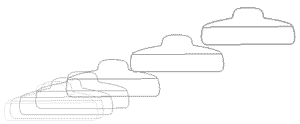

 |
|||
 |
Japanese Animation Camera Work (continued)
 Let's say this UFO is accelerating from a stop. The first few images on the cels will be very close together but the distance between them will grow on each successive frame.
 The timing for this move:
Played in succession the UFO will appear to be speeding up.

Pan
Zip pan (ryu pan) This is not so much a pan as it is the usage of a long pan background. The background has lines instead of clearly defined images and is used to give an impression of dynamic movement. For the sake of cut to cut consistency, the ryu pan BG is normally made up of colors that would normally be in the backgrounds for that sequence. Sometimes a ryu pan is used in part of a normal pan to give it added speed for that section.
An Image BG is usually just a wild splatter of colors that is used in cuts dealing with emotional content, the inside of the character's head, New Type heaven, other dimensions or any other cut where a normal BG image wouldn't work right or isn't necessary. It can be used just like a ryu pan. The colors do not necessarily have to be the same as the ones used in the normal backgrounds for that sequence and are often totally different in order to add more contrast to the cuts they are used in.
Both ryu pan and image BG backgrounds are often repeated (see follow) and are also used multiple times in a single show and kept throughout the production of a series.
Overlay, Book
 Overlay/book |